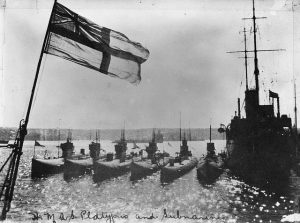- Author
- A.N. Other
- Subjects
- History - general, Ship design and development
- Tags
-
- RAN Ships
- None noted.
- Publication
- September 2011 edition of the Naval Historical Review (all rights reserved)
By Midshipman John Lee
This essay, which won the Naval Historical Society history prize in 2010, has been purposely held back for inclusion in this edition of our magazine which is devoted to submarine warfare. John Lee joined the RAN in 2002 as an electronics technician. After initial training he transferred to the submarine branch and was first posted to HMS Sheean and later HMS Rankin. After gaining his commission in 2010 he is now studying electrical engineering at the Royal Melbourne Institute of Technology. On completion of his studies Midn Lee intends returning to the submarine squadron as a Weapons Electrical Engineer.
‘Unheard they work, unseen they win. That is the custom of ‘The Trade.’
Rudyard Kipling1
Introduction
When he was Prime Minister, Kevin Rudd highlighted the importance of submarines for maintaining the security of our country.2 Historically however, the same level of support has not always been received and since federation there has been debate as to whether submarines are the best option for the Royal Australian Navy (RAN.)3 Prior to the first Oberon class Submarine in 1967, the RAN acquired four different classes of submarines with varying degrees of success and significance.
This essay briefly examines each of the four classes of submarines prior to the Oberon class, highlighting major events. It will then evaluate the level of significance of each class, any lessons learnt and whether they were an effective use of defence spending.
The ‘E’ Class
The first submarines acquired by Australia were of the ‘E’ type, ordered from Vickers Maxim in England in 1910, and commissioned into the RAN in February 1914. Two submarines were acquired and given the designations AE1 and AE2. After commissioning in England, both boats commenced an 83 day transit to Port Jackson, in Australia, setting a submarine endurance record on the way.4
AE1 is the subject of one of the greatest mysteries of the RAN. During a patrol off Papua New Guinea in September 1914, AE1 disappeared without a trace and to this day has never been found. AE1 was the first loss to the Australian fleet and the first allied submarine sunk during World War One. It is not believed that she was sunk by enemy action but more likely by accident.5
AE2 has become very well known for her exploits in the Dardanelles. The Turkish forces at Gallipoli relied on shipping for resupply, and it was believed that if a submarine could penetrate the 35 mile Dardanelle Strait and reach the Sea of Marmara, it would create havoc amongst the enemy shipping, thus assisting the ANZAC landing at Gallipoli.6 Two submarines tried and failed before AE2 penetrated the Dardanelles on April 25, 1915. She spent the next five days harassing the enemy in which time she sank a Turkish mine laying cruiser, and caused confusion for the Turkish fleet. She was eventually sunk on 29 April after hits from a Turkish gunboat.7
While the life of the ‘E’ class was very short, they however gave the RAN a significant foray into submarine warfare. During what was described at the time as ‘the finest feat in submarine history’,8 AE2 significantly contributed to the efforts of the ANZAC landing at Gallipoli and thoroughly enhanced the reputation of the RAN. For this reason alone, the E class submarines proved to be a very good use of defence spending.

‘J’ Class
After WWI the British Admiralty gifted Australia with six ‘J’ class submarines. These were considered too large and expensive to remain in British service. The six submarines arrived in Sydney in July 1919, where it was discovered that the boats were in poor repair after years of war service, and were put into immediate refit. This refit proved slow and expensive and was fraught with difficulty. The facilities were inadequate to cope with submarine refit and very few technical personnel had sufficient knowledge of the requirements of submarine maintenance. This resulted in the cost of refitting the six boats blowing out from the original maintenance cost estimates provided by the Admiralty. Despite these difficulties a submarine flotilla was formed at Osborne House in Geelong. This flotilla remained in operation until August 1922 when due to pressure to decrease Navy expenditure, the ‘J’ class were decommissioned.9




